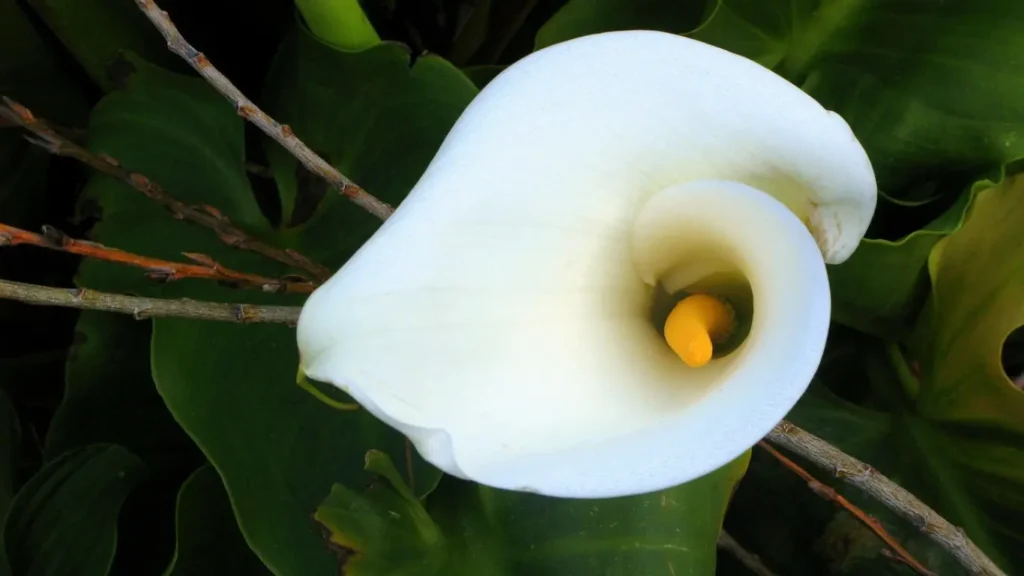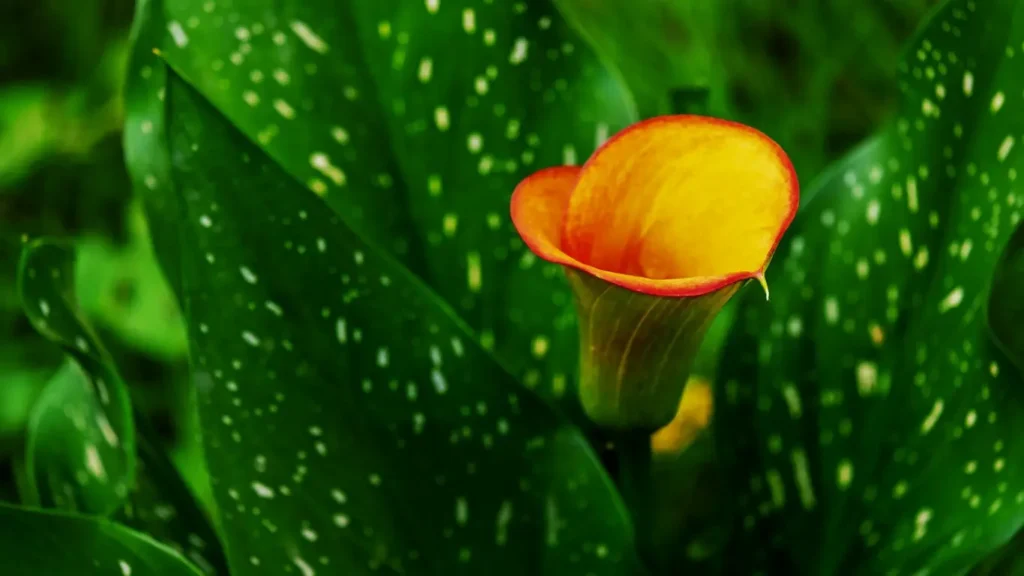
Calla Lilies (Zantedeschia), with their elegant, trumpet-shaped spathes and lush foliage, bring a touch of sophistication to any garden or home. This definitive guide provides everything you need to know about how to grow Calla lily successfully, from planting rhizomes to ensuring spectacular blooms year after year, covering both indoor and outdoor cultivation.
Table of Contents
Calla Lily (Zantedeschia) Care at a Glance: Key to Success
Understanding the fundamentals of calla lily care is essential for successful cultivation. Here are the critical care requirements every gardener should know:
• Plant Type: Tender perennial grown from rhizomes • Light: Full sun to partial shade (afternoon shade in hot climates is ideal) • Soil: Rich, moist, well-draining soil • Watering: Keep consistently moist during active growth; reduce when dormant • Planting Depth (Rhizomes): 2-4 inches deep • Spacing: 12-18 inches apart • Hardiness Zones: Typically 8-10 as perennials; lift and store or grow as annuals/houseplants in colder zones • Fertilizing: Balanced liquid fertilizer every 2-4 weeks during growth • Toxicity: All parts are toxic to pets and humans if ingested
Meet the Calla Lily: More Than Just a White Flower
What is a Calla Lily? (Not a True Lily!)
Despite their common name, calla lilies aren’t true lilies at all. These stunning plants belong to the Araceae family, making them relatives of peace lilies and philodendrons. What most people consider the “flower” is actually a spathe—a modified leaf that surrounds the true flowers found on the central spike called a spadix. This unique structure creates the distinctive trumpet shape that makes calla lilies so recognizable and sought-after in gardens and floral arrangements.
Origins & Natural Habitat (Southern Africa)
Native to southern Africa, calla lilies evolved in regions with distinct wet and dry seasons. This natural habitat explains their need for consistent moisture during active growth followed by a drier dormancy period. Understanding their origins helps gardeners provide optimal growing conditions, whether cultivating these beauties in Mediterranean climates or adapting care for different regional conditions.
The Two Main Groups of Calla Lilies
Zantedeschia aethiopica types: These larger, typically white varieties are more moisture-loving and cold-hardy. They can often survive light frosts and prefer consistently moist conditions, making them excellent choices for water gardens or bog-like settings.
Hybrid Cultivars: Smaller plants offering a spectacular range of colors including yellow, orange, pink, purple, and near-black varieties. These hybrids are often less cold-hardy and typically require a distinct dry dormancy period to bloom reliably the following season.
This distinction is crucial for proper calla lily care, as each group has slightly different requirements for optimal growth and flowering.
Planting Calla Lilies for Guaranteed Success: From Rhizome to Bloom
Choosing Healthy Calla Lily Rhizomes (or Plants)
Success with calla lilies starts with selecting quality planting material. Look for firm, plump rhizomes with visible eyes or growing points. Avoid soft, mushy, or shriveled rhizomes, as these may be diseased or damaged. Fresh rhizomes should feel solid and show no signs of rot or mold.
When to Plant Calla Lilies
Outdoors: Plant after all danger of frost has passed and soil temperatures consistently reach 65°F (18°C). In most regions, this occurs in late spring to early summer.
Indoors: Start rhizomes 6-8 weeks before the last expected frost date for earlier blooms, or grow them year-round as houseplants in appropriate containers.
Soil Preparation: The Perfect Bed for Your Callas
Calla lilies thrive in rich, organic soil with excellent drainage. Prepare planting beds by incorporating 2-3 inches of compost or well-aged manure. The ideal pH ranges from 6.0 to 7.0—slightly acidic to neutral. Heavy clay soils should be amended with sand and organic matter to improve drainage, while sandy soils benefit from additional organic matter to retain moisture.
How to Plant Calla Lily Rhizomes: Step-by-Step
- Dig holes 2-4 inches deep and 12-18 inches apart
- Position rhizomes with growing points (eyes) facing upward
- Cover with soil and water gently but thoroughly
- Apply mulch around planted areas to retain moisture and suppress weeds
- Mark locations to avoid accidental disturbance while shoots emerge
Growing Calla Lilies in Pots & Containers
Container growing offers excellent flexibility, especially in colder climates. Choose pots at least 12 inches wide with multiple drainage holes. Use a high-quality potting mix enriched with compost. Container-grown calla lilies can be easily moved indoors for winter protection or relocated for optimal growing conditions throughout the season.
Growing Calla Lilies Indoors as Houseplants
Indoor cultivation requires attention to light, humidity, and air circulation. Place containers near bright, indirect light sources and maintain humidity levels around 50-60%. Regular rotation ensures even growth, and adequate ventilation prevents fungal issues common in indoor environments.

Calla Lily Care Throughout the Seasons: A Comprehensive Guide
Light Requirements: Sun, Shade, and Everything In Between
Most calla lilies perform best with morning sun and afternoon shade, especially in hot climates. Zantedeschia aethiopica varieties tolerate more shade than colorful hybrids, which need adequate light for optimal flowering. Signs of insufficient light include weak, spindly growth and reduced flowering, while excessive direct sunlight may cause leaf scorch and stress.
Watering Wisdom: Keeping Callas Consistently Moist (But Not Soggy)
Proper watering is critical for healthy calla lily care. During active growth, maintain consistent soil moisture without waterlogging. Water deeply but less frequently to encourage strong root development. As plants enter dormancy, gradually reduce watering frequency. Mulching helps retain soil moisture and regulate temperature fluctuations.
Feeding Your Calla Lilies: Fueling the Flowers
Feed actively growing calla lilies every 2-4 weeks with balanced liquid fertilizer diluted to half strength. During flowering periods, switch to a fertilizer higher in phosphorus and potassium to promote bloom production. Avoid excessive nitrogen, which encourages leafy growth at the expense of flowers.
Deadheading & Pruning: Encouraging More Blooms & Tidy Plants
Remove spent flowers promptly to encourage continued blooming and prevent energy waste on seed production. Cut flower stems back to the base of the plant. As foliage begins yellowing naturally during dormancy, allow it to die back completely before removal—this process helps nourish the rhizome for next season’s growth.
Calla Lily Dormancy & Overwintering: Essential Steps for Cold Climates
Understanding Calla Lily Dormancy
Many hybrid calla lilies require a dormancy period to bloom reliably. Signs of dormancy include yellowing leaves and cessation of new growth. This natural process typically occurs in fall and is essential for flower bud formation.
Overwintering Calla Lilies in the Ground (Zones 8-10)
In warmer climates, calla lilies can remain in the ground year-round. Apply a thick layer of mulch after the first light frost to protect rhizomes from temperature fluctuations. Remove dead foliage in late winter before new growth begins.
Lifting and Storing Calla Lily Rhizomes (Colder Zones)
For gardeners in zones 7 and colder, lift rhizomes after foliage dies back:
- Carefully dig rhizomes after first frost kills foliage
- Clean off soil and remove dead roots and foliage
- Cure in sun for several days until outer skin firms up
- Store in cool, dry location (45-55°F) in slightly moist peat moss or sawdust
- Check periodically and remove any soft or rotting rhizomes
Overwintering Potted Calla Lilies
Container plants can be moved to protected locations like unheated garages or basements. Reduce watering significantly but don’t allow rhizomes to completely dry out. Resume normal care when new growth appears in spring.
Exploring the Rainbow: Stunning Calla Lily Varieties & Colors
The diversity of calla lily varieties offers options for every garden design and color preference:
White Varieties:
- Zantedeschia aethiopica: Classic white with yellow center
- ‘Green Goddess’: White with distinctive green markings
Yellow Varieties:
- ‘Golden Chalice’: Bright golden-yellow blooms
- ‘Captain Solo’: Compact with clear yellow flowers
Pink/Rose Varieties:
- ‘Captain Rosette’: Soft pink with darker centers
- ‘Pink Melody’: Vibrant rose-pink blooms
Orange/Red Varieties:
- ‘Captain Safari’: Bold orange-red coloration
- ‘Flame’: Intense red-orange flowers
Purple/Black Varieties:
- ‘Black Star’: Deep purple-black blooms
- ‘Odessa’: Rich purple coloration
- ‘Captain Odeon’: Nearly black flowers with dramatic appeal
Calla Lily SOS: Identifying and Solving Common Issues
| Problem | Likely Cause(s) | Solution(s) |
|---|---|---|
| Failure to Bloom | Immature rhizome, insufficient light, improper dormancy, nutrient imbalance | Ensure adequate light, proper dormancy period, balanced fertilization |
| Yellowing Leaves | Overwatering, underwatering, nutrient deficiency, natural dormancy | Adjust watering schedule, check drainage, fertilize appropriately |
| Brown Leaf Tips/Edges | Low humidity, inconsistent watering, fertilizer burn | Increase humidity, maintain consistent moisture, reduce fertilizer concentration |
| Aphids | Common garden pest | Use insecticidal soap or introduce beneficial insects |
| Spider Mites | Low humidity, hot conditions | Increase humidity, use miticide if severe |
| Rhizome Rot | Overwatering, poor drainage | Improve drainage, remove affected rhizomes, treat with fungicide |
Multiplying Your Calla Lilies: Propagation by Division
The most reliable method for expanding your calla lily collection is through rhizome division:
- Timing: Divide during dormancy or just before spring replanting
- Lift rhizomes carefully from soil or containers
- Identify natural separation points where smaller rhizomes have formed
- Cut cleanly with sharp, sterile knife if necessary
- Ensure each division has at least one growing point
- Allow cut surfaces to dry for 24-48 hours before planting
- Plant divisions following standard planting procedures
Beyond the Garden Bed: Using Calla Lilies
Cut Flower Tips
Calla lilies make exceptional cut flowers with proper harvesting:
- Cut stems early morning when fully hydrated
- Choose flowers just beginning to open
- Place immediately in cool water
- Recut stems under running water
- Change water every 2-3 days for longest vase life
Landscape Design Ideas
Border Plantings: Create dramatic edges with sequential bloom times Container Gardens: Mix varieties for extended color displays Waterside Planting: Zantedeschia aethiopica excels near water features Indoor Arrangements: Potted specimens provide seasonal indoor color
Calla Lily Toxicity: A Warning for Households with Pets & Children
Important Safety Information: All parts of calla lilies contain calcium oxalate crystals, making them toxic to humans and pets if ingested. Symptoms may include mouth irritation, difficulty swallowing, and digestive upset. Keep plants away from curious children and pets, and seek medical attention if ingestion occurs.
Your Top Calla Lily Questions Answered (Expert FAQ)
Are Calla Lilies bulbs or perennials?
Calla lilies grow from rhizomes (underground stems), not true bulbs. They’re tender perennials that can survive year-round in zones 8-10, while gardeners in colder zones treat them as annuals or lift rhizomes for winter storage.
How long do Calla Lilies bloom?
Individual flowers last 2-3 weeks, while the overall blooming season extends 6-8 weeks with proper care. Sequential planting and variety selection can extend the display period.
Do Calla Lilies need full sun?
Most calla lilies prefer morning sun with afternoon shade, especially in hot climates. White varieties tolerate more shade than colorful hybrids, which need adequate light for best flowering.
Can I leave Calla Lily rhizomes in the ground over winter?
This depends on your climate zone. In zones 8-10, rhizomes can remain in the ground with mulch protection. Colder zones require lifting and indoor storage for winter survival.
Why are my Calla Lily flowers green?
Some varieties naturally have green markings, while others may produce green flowers due to genetics, age, or environmental stress. This is typically not a cause for concern.
Your Journey to Breathtaking Calla Lily Displays
Mastering how to grow Calla lily successfully opens doors to years of elegant blooms and garden sophistication. With proper attention to their unique needs—from understanding dormancy requirements to providing optimal growing conditions—these remarkable plants reward gardeners with unmatched beauty and reliability.
Whether you choose classic white varieties for timeless elegance or explore the vibrant spectrum of hybrid colors, calla lilies offer versatility for every garden style and growing situation. Their adaptability to both outdoor gardens and indoor containers makes them accessible to gardeners regardless of climate or space limitations.
What are your favorite Calla Lily colors or growing tips? Share your experiences and questions in the comments below!
Author
George Wine is a seasoned gardening expert with over 20 years of experience in the field of horticulture. His passion for plants and nature has driven his career, where he has honed his skills in various aspects of gardening, from landscape design to plant care. George holds a Master of Science in Horticulture from the University of California, Davis (UC Davis), a prestigious institution known for its research and advancements in plant science.
Throughout his career, George has worked with a diverse range of clients, offering tailored solutions to enhance outdoor spaces and create thriving gardens. His knowledge and expertise allow him to provide invaluable advice, ensuring that both novice and experienced gardeners achieve their gardening goals. Whether you’re looking for tips on sustainable gardening practices, innovative design ideas, or advice on specific plant species, George is here to help you cultivate the garden of your dreams.






